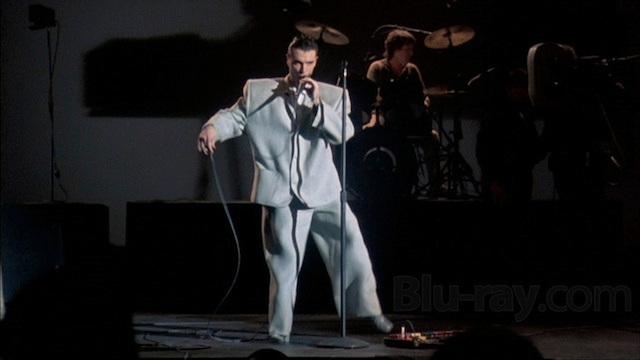
Jonathan Demme’s 1984 concert film, Stop Making Sense, begins simple enough. Talking Heads front man David Byrne walks onto a bare stage and places a boombox on the ground. “Hi, I got a tape I wanna play you,” he quips. Byrne turns on the stereo and the musician’s acoustic guitar soon melds to a tight backing track. The band’s ever popular “Psycho Killer” follows.
With each succession song, the platform evolves— Byrne’s solo enterprise snowballing as band members join the show one by one. Bassist Tina Weymouth appears stage left. The crew roll out risers. Chris Frantz hops on the drums for the third ballad. Eventually, the nine-piece ensemble is complete. A backdrop falls and now we’re kicking.
Watching Stop Making Sense feels a bit like observing the act of creation firsthand. Specifically, creation aimed toward culmination. If the slow fruition at the beginning of the set alludes to anything, it’s that David Byrne and co. are building towards a crescendo that will bring all—artist and spectator alike—toward a collective sense of unity and illumination.
While Byrne’s onstage aerobics (he’s really putting in some cardio up there) propel the movie toward its natural climax and denouement, Demme’s watchful eye transforms Stop Making Sense into something akin to a spiritual experience. In less capable hands, concert films operate observationally. We watch. The musicians play. Hopefully the songs are catchy. In Demme’s film (aided by cinematographer Jordan Cronenweth), the camera feels less like a tool and more like a phantom sanctioning the band’s performance art. The stage is alive—a place outside of space and time. Consequently, Stop Making Sense functions not simply as a historical document—a record of a good band singing good tunes—but a moment where music, technical proficiency, and pure, raw energy create a kaleidoscope of joy, harmony, and (above all) anticipation.
Near the end of the film, David Byrne appears in the now legendary “big suit.” The symbolism is as rich as it is playful and eccentric. The machinations of modern society—the roles we’re told to play and play well—threaten to engulf us.
Might there be a way out?
The answer comes in the film’s closing minutes while the band plays “Crosseyed and Painless.” During the song’s conclusion, Demme pulls back the curtain and cuts (for the first time) to a series of audience shots. We watch as the crowd moves with the twitch of a rowdy camp meeting. It’s a jubilant celebration—a diverse crowd; a diverse band; a singular experience. Artistic creation has reached its longing.
This moment refracts the band’s earlier song “Heaven,” a track lamenting a drab and perfunctory afterlife. If an eternity that lacks creative imagination feels like a disappointing endcap to the richness of human life, Demme and the band offer an alternate account. Their version of spiritual rest sees fulfillment in a multitude of distinct voices, shedding their robes of greed, apathy, and consumerism. If charismatics and Pentecostals (groups that Byrne emulates in his choreography) view movement and emotion as pivotal to experiencing the God who made their bodies, Stop Making Sense understands that breath, perspiration, and physicality are key contributors to spiritual receptivity.
But first, there must be a cleansing. “Take me to the river, drop me in the water,” Byrne sings while shedding his oversized suit jacket in “Take Me to the River.” Here, as Demme shoots the band in near celestial light, one wonders if he believes the show might be a visual metaphor for baptism. Or, at least the desire for divine baptism—the end of our searching.
The old has gone, the new is here.
— Wade Bearden, co-host of Seeing and Believing
- Directed by: Jonathan Demme
- Produced by: Gary Goetzman Gary Kurfirst
- Written by: Jonathan Demme Talking Heads
- Music by: David Byrne Chris Frantz Jerry Harrison Talking Heads Tina Weymouth
- Cinematography by: Jordan Cronenweth
- Editing by: Lisa Day
- Release Date: 1984
- Running Time: 88
- Language: English
Arts & Faith Lists:
2020 Top 100 — #63